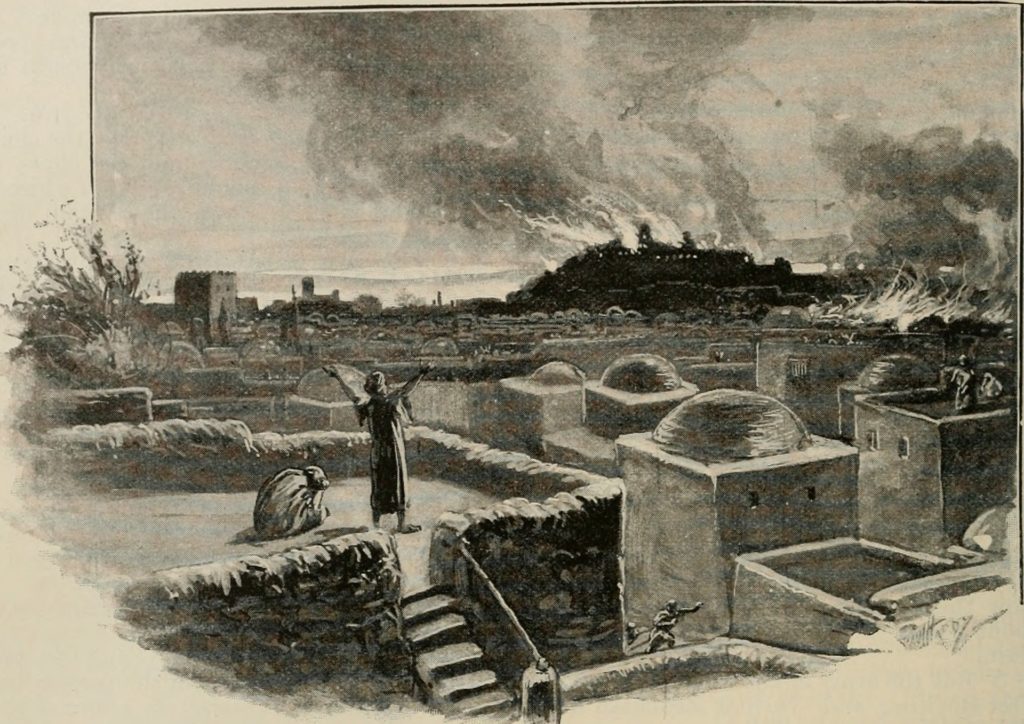Nebuchadnezzar was king of the Neo-Babylonian Empire during the 6th century BC. He was one of the ancient world’s most powerful and influential rulers and is known for his military conquests and construction of the Hanging Gardens of Babylon.
Nebuchadnezzar was the son of Nabopolassar, the founder of the Neo-Babylonian Empire. He became king at a young age and quickly began to expand the empire through military conquests. He conquered the Assyrian capital of Nineveh in 612 BC and the Kingdom of Judah and Jerusalem in 597 BC and 587 BC, respectively.
He is described as being physically short but with such an imposing, intimidating, and threatening demeanor that his officials would often tremble even when far from him. He had a high ambition backed by his ironclad will to achieve great things, namely conquering and subduing the world.
The Sack of Jerusalem in 587 BC was an important event in the history of ancient Jerusalem. It occurred when the Babylonian king Nebuchadnezzar II invaded the city and laid siege to it, ultimately conquering it and destroying many of its important buildings and monuments.
Despite its importance, the Sack of Jerusalem is not well-known today. It is often overshadowed by other events in ancient history, such as the fall of Rome or the conquests of Alexander the Great. However, it remains an important moment in the history of Jerusalem and the ancient Near East.

What Caused The War
Nebuchadnezzar had conquered Askelon, a prosperous City under Israel. He then imposed a tax on King Jehoiakim of Judea and the kings of Syria and Israel. Jehoiakim was torn between paying the taxes to Nebuchadnezzar and paying taxes to the Pharaoh of Egypt, who had earlier imposed a tax.
Jehoiakim would then work with the Pharaoh to rebel against Nebuchadnezzar. But Nebuchadnezzar captured him, killed him, and appointed his 18-year-old son Jehoiachin as King. But his reign lasted a few months before Nebuchadnezzar came to Jerusalem, captured him and thousands of his citizens, and looted the city. Nebuchadnezzar then appointed Jehoiachin’s uncle, Zedekiah, as King.
It was not long before Zedekiah toed Jehoiakim’s path to rebel against the Babylonian king. What followed was the devastating response of Nebuchadnezzar.
How it Happened
The sack of Jerusalem in 587 BC occurred in July (the month of Tammuz) 15 of that year, according to the most commonly accepted chronology. It was carried out by the Babylonian king Nebuchadnezzar II, who had previously conquered the neighboring kingdom of Assyria and was looking to expand his empire further.
The Sack of Jerusalem was part of a broader campaign by Nebuchadnezzar to expand the Babylonian Empire and extend its control over the region.
At the time, Jerusalem was a major city in the kingdom of Judah, one of two major powers in the region. It was a wealthy and powerful city with strong fortifications and a well-trained army.
Before the sack of Jerusalem, Nebuchadnezzar had already defeated the kingdom of Judah in battle and taken its king, Jehoiakim, into captivity. However, Jerusalem itself remained independent and defiant, despite the Babylonian threat.
Despite its strength, Jerusalem was no match for the Babylonian army. Nebuchadnezzar, therefore, decided to lay siege to the city, cutting off its supplies and blockading it from the outside world. This siege lasted for several months, during which time the city’s inhabitants suffered hunger, disease, and other hardships.
Finally, on July 15, 587 BC, the Babylonians breached the city’s walls and entered Jerusalem. Once inside the city, the Babylonians began systematically destroying its buildings and monuments. The Temple of Solomon, one of the city’s most important and sacred structures, was burned to the ground. The city’s walls were torn down, and many inhabitants were killed or taken captive.
The Babylonians also killed many of the city’s inhabitants and took others captive. Among those who were captured was the prophet Ezekiel, who was later exiled to Babylon. This event is mentioned in the Bible in the book of Ezekiel, which is referred to as “the day of the Lord’s anger” (Ezekiel 7:19).
The event was a devastating blow to the kingdom of Judah and a turning point in the city’s history. It marked the end of Jerusalem’s status as a major power and its decline as a center of trade and commerce. It also had far-reaching consequences for the people of Judah, who were forced to live under Babylonian rule for many years.
Nebuchadnezzar humiliated the Israelite captives and used them as slaves and workers for a long time.
What Happened to King Nebuchadnezzar After?
After the Sack of Jerusalem, Nebuchadnezzar II continued to expand the Babylonian Empire and extend its control over the region. He conquered many other cities and territories, including the kingdom of Judah and its capital, Jerusalem.
He also made Babylon a major center of trade and commerce and oversaw the construction of many impressive buildings and monuments, including the famous Hanging Gardens of Babylon.
Nebuchadnezzar’s rule was not without its challenges, however. He faced opposition and rebellion from some of the conquered peoples and had to put down several uprisings. He also had to deal with the threat of other powers, such as the Assyrians and the Persians, who were expanding their own empires and challenging Babylonian dominance.
Despite these challenges, Nebuchadnezzar maintained his hold on the Babylonian Empire and its position as a major power in the ancient world. He is remembered as one of the ancient Near East’s most powerful and successful rulers, and his legacy continues to be felt today.

